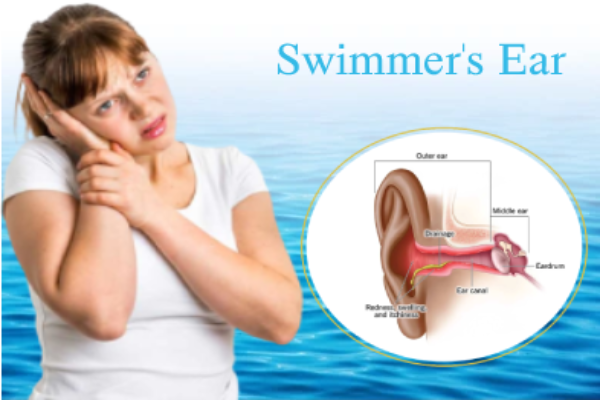The ear is divided into three parts by way of structure and function – The External Ear, Middle Ear, and Inner Ear.
 The External ear consists of the Pinna and the External Auditory canal up to the ear drum (Tympanic Membrane).
The External ear consists of the Pinna and the External Auditory canal up to the ear drum (Tympanic Membrane).
Infection of the External ear is termed as Otitis Externa and ‘Swimmer’s Ear’ is another loosely framed term for an infection of the External Ear.
The external ear is very richly supplied by Sensory Nerves – this makes it very sensitive to pain. An infection of the outer ear or middle ear thus can be a very painful affair.
In India the swimming season is usually in the summer and monsoon months.
During this time, because of the heat and humidity, the chances of catching an external ear infection is more.
This is also the time of summer vacations from school and people, specially children, spend a lot of time in the water.
Prolonged presence of water in the ear, specially if there is pre existing wax (which blocks the free flow of water in the ear) can cause an infection which could be bacterial or fungal.
What do you feel in Swimmer’s Ear ?
- Ear blockage
- Itching
- Stiffness and discomfort
- Pain
- Discharge
- Impaired hearing
The pain increases on touching or pulling the ear or on chewing.
There may be outside appearance of redness and swelling.
There is an initial feeling of blockage or itching. This progresses to pain and impairment in hearing. Sometimes there is intense pain because the external ear is very sensitive to pain.
How to Prevent-
Keep ears dry, remove wax if your ears are prone to wax development by seeing an ENT Specialist before the swimming season
- Use well fitting ear plugs – these are readily available in sports shops or can even order online. Make sure they are neither loose nor too tight.
- Wear a cap to cover your ears – this too prevents water from entering the ears
- If water accidentally enters your ears try to gently remove by brushing the outside of your ear – do not insert ear buds deep inside your ear
- Self help – introduce a drop of household vinegar mixed with a drop of spirit into the ear – be careful though. It is completely contraindicated if you have a history of ear discharge, previous middle ear infection, grommet insertion etc.
What can you do for Swimmer’s Ear?
- Use OTC pain relieving ear drops-
- Antifungal / Antiseptic ear drops in case of itching and pain
In the presence of increasing infection, pain, blockage and loss of hearing you must consult an ENT Doctor – even for children. This is because some ear cleaning may need to be done and an ENT Specialist has the equipment to perform that.
Treatment of Swimmer’s Ear by the Doctor
- Ear cleaning
- Wax removal
- Irrigation with water if necessary
- Pain relieving or antiseptic/ antifungal dressing
- Repeat visits may be necessary, specially i
Caution
- Do not insert ear buds or any other foreign substance inside the ear
- Never pour oil into the ear in such instances- you are sure to get a bad fungal infection
- Diabetics need to be very careful about their ears – ear infection in the presence of uncontrolled diabetes can be very difficult to treat.
- Sometimes Seborrhoea (Dandruff) can cause an infection of the outer ear – do let your doctor know about your dandruff history.
So enjoy your swim but stay safe.

